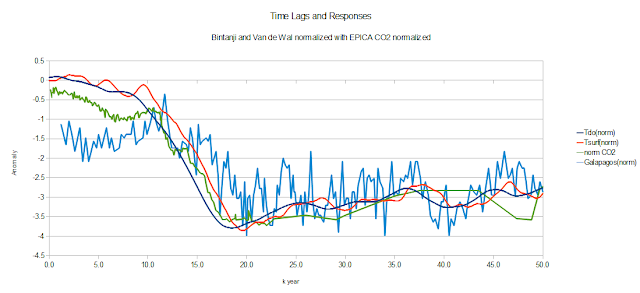CO2 is a radiantly active gas and will, like a blanket, reduce the heat loss from the planet. Since it is not the only radiantly active gas, how effective a blanket it will be, depends.
The Bintanji and Van de Wal paleo reconstruction for the past 3 million years is an impressive compilation that simplifies the comparison of lags. Since the temperatures are based on primarily 45N to the pole data, they are not truly "Global" but very useful.
The chart above is a comparison of the normalized value of Tdo (deep ocean), Tsurf (surface) and CO2 (as anomaly scaled to Tdo and Tsurf). The CO2 anomaly matches the Tdo reconstruction quite well and lags Tsurf. Surface temperatures then based on this data did not "cause" the rise in surface temperature. Since the Tdo and CO2 match well, what "caused" what is not easily determined.
Since the CO2 data is from the Antarctic and the Bintanji data from the northern higher latitudes, the match between Tdo and CO2 could indicate a Southern Hemisphere "cause". The standard Global Warming textbooks though do not spend much time on the lead lag relationship.
There is no obvious relationship in the paleo data to accurately estimate what the impact of a doubling of CO2 might be. The "Textbooks" do mention that is the far distant past that CO2 was much higher as was temperature. Those texts do not go into much detail on the lead and lag relationships nor do they consider the ocean circulation well.
By adding the Lea et al. Galapagos temperature reconstruction, normalized and scaled for comparison, we also have a temperature lead of CO2, but with a divergence at the end. Too much noise to work with, but at the divergence there appears to be a hint of actual CO2 inspired warming. Still CO2 and land use are closely related and the deep ocean is capable of holding quite a bit of CO2. So much data so little time. Stott and company though are looking likely a good crew to follow though.


No comments:
Post a Comment